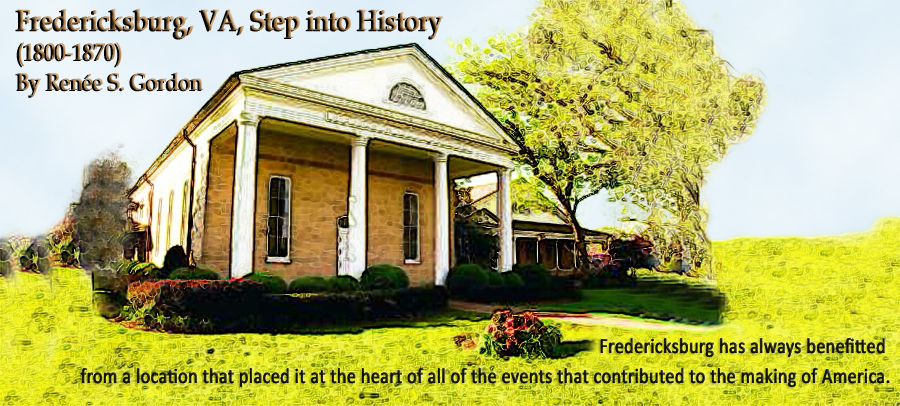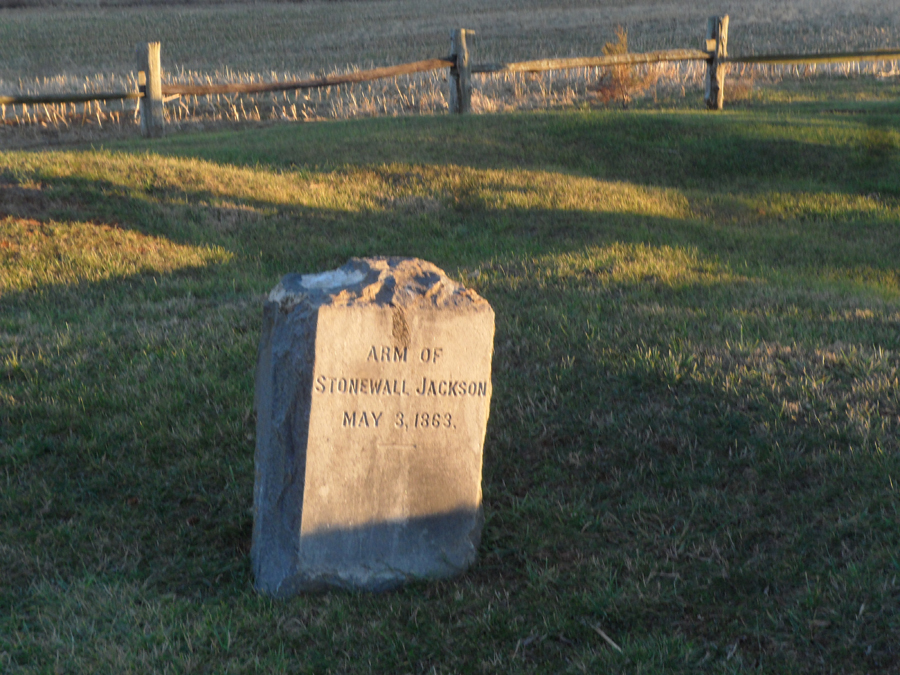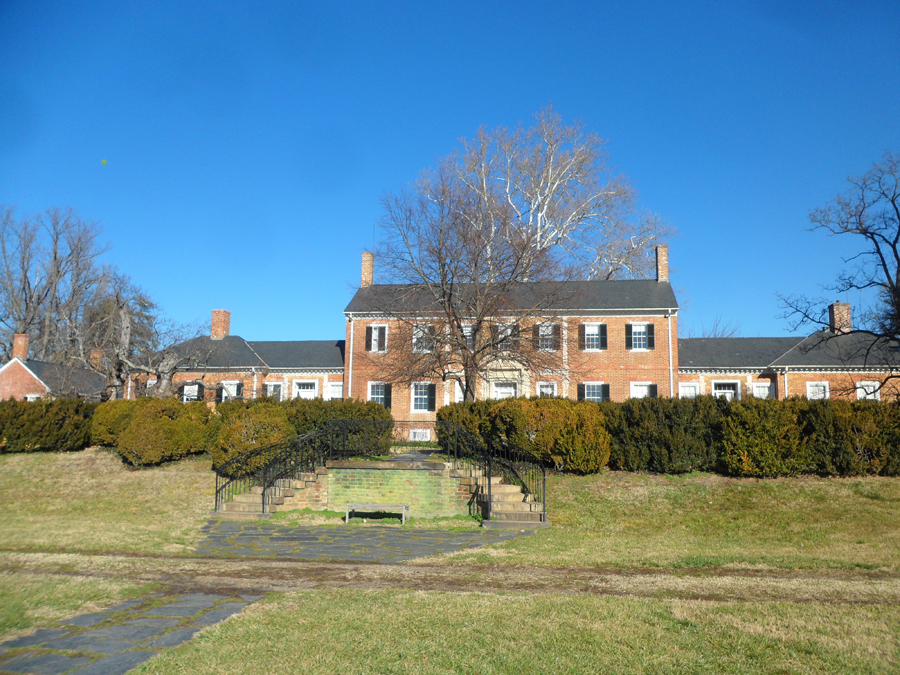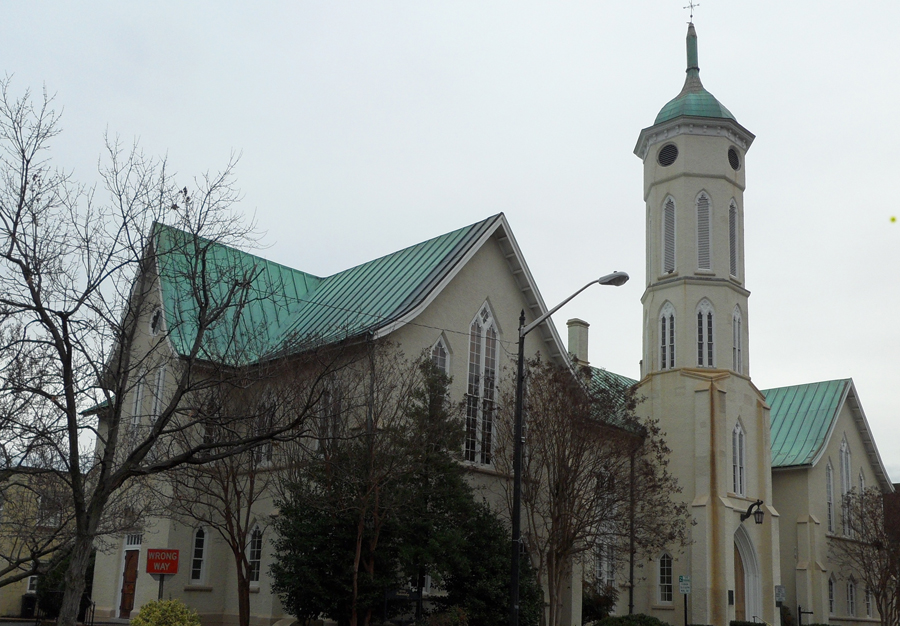|

It thrived as an inland port, was an early urban center and
served as a gateway to westward expansion. The institution of
slavery was interwoven in every event and activity and by the
onset of the Civil War the population consisted of approximately
50% people of African descent with 1,200 slaves, 350 free blacks
and 3,000 whites. An
African American male in his prime sold for about $1500, $40,000
in modern currency.
Many free blacks moved to Fredericksburg in the 1830s to help
build a canal. The canal was not a success but the men remained
creating a neighborhood known as Liberty Town. It remains an
African American community.
Enslaved workers walking into town were required to have a pass
or risk arrest. Their only access to town without one was by
means of Free Alley, a footpath on George Street to downtown.
The path can still be seen.
Shiloh Old Site Baptist Church
was originally Fredericksburg Baptist Church. Services were held
with whites on the ground floor, free blacks in the balcony
facing the altar and slaves in the balcony seated on the sides.
All blacks entered by a separate door. In 1854 the white
congregation sold the church to the black Baptists who renamed
it and it became the first black church in the area. Although
the congregation was black they were legally required to have a
white overseer present. George Rowe became the minister/overseer
at a charge of $50 a month. Rowe resigned when the Emancipation
Proclamation was passed. During the war it was used as a
hospital, barracks and stable.
www.shiloholdsite.org
A residence at Charles and Frederick Streets was once the
property of George Aler, one of the city's largest slave
dealers. This was the site of his slave jail, a holding area for
men, women and children who were to be traded. Ironically, only
a few steps away was the home of Mary Minor Blackford, an
antislavery activist.
Mary was born into a slave owning family but as an outspoken
critic of the system. She and her husband were active in the
American Colonization Society and she founded a group to raise
money to help blacks migrate to Liberia and educate females once
they were there. Dolley Madison was a member of her
organization.
The Blackford family owned slaves and Mary taught her slaves to
read, an act that was illegal. She taught them one at a time
because it was illegal for a black person to testify against a
white person. During the Civil War Mary's family was split with
some members serving in the Confederate Army.
Mary was not alone in the area in her opposition to slavery. The
Moncure Conway House is a designated National Underground
Railroad Network site in Falmouth. The 1807 Federal-style
residence was the homestead of the wealthy slaveholding Conway
family. Moncure, one of the sons, attended Dickinson College in
PA and Harvard Divinity School. He accepted a job in 1854 as a
Unitarian minister but was dismissed for preaching his
antislavery opinions. In 1862, learning of conditions in
Fredericksburg, he returned to assist his family's slaves. They
had gone into hiding but he traced approximately 30 of the 50 to
Georgetown in Washington, DC in July of 1862. He arranged for
official permission to remove them from the area and purchased
train tickets to Ohio for the group. Leaving nothing to chance
he accompanied them on the train through the slave states and
resettled them in Yellow Springs, Ohio. The area is still
referred to as the Conway Colony. Conway felt that the
Emancipation Proclamation did not go far enough. He moved to
England in 1863 but continued to rally support for the North.
www.nps.gov/nr/travel/underground/moncureconway
The attributes that had contributed to Fredericksburg's
prosperity were the elements that made it important to both
sides during the Civil War. The city is equidistant between
Richmond, the capitol of the Confederacy and Washington, DC, the
Union capitol. Control of the area was essential for both sides
to prevent invasion of their capitols. Fredericksburg also had
access to a port that could be used to supply troops and it was
a manufacturing city. Four major battles were waged in the
immediate area, Fredericksburg would change hands numerous times
and the region would be bathed in the blood of 105,000
casualties. All of the battlefields have signage in the form of
interpretive plaques and a 15-mile driving trail connects three
of the battlefields.
The Battle of Chancellorsville took place from April 27-May 6,
1863. Robert E. Lee and Stonewall Jackson scored a Confederate
victory over
Major General Joseph Hooker's forces as they attempted to cross
the Rappahannock River to surround Lee's troops even though the
Union significantly outnumbered them. The greatest battle loss
was the wounding of Jackson at 9:30 PM on May 2nd
accidentally by his own men. He died of pneumonia 8 days later.
Chancellorsville Visitor Center features displays and an
orientation film. A 12-mile looping battlefield trail visits 10
locations including the site where Lee and Jackson bivouacked on
May 1st and the place where Jackson was wounded.
Ellwood Manor, a 1790 house was part of a 5,000-acre plantation
that is the last standing structure remaining from the battle.
The simple eight-room house served as a summer residence for the
Lacy family. Lee camped here and during the Battle of the
Wilderness Generals Burnside and Warren established headquarters
there. The house was used as a hospital, the floors became
bloodstained and soldiers left graffiti that remains visible.
www.nps.gov/frsp/chanville
Stonewall Jackson's arm was amputated as a result of his being
wounded in 1863. Common practice was for surgeons to throw
amputated limbs into a pile outside the medical facility.
Reverend Lacy, a military chaplain, rescued the arm and buried
it in a cemetery at the rear of Ellwood. Mrs. Jackson did not
want him disturbed so the arm remained there. In 1904 a stone
marker was placed there by one of his officers.
www.nps.gov/frsp/ellwood
 |
|
Stonewall's Arm
|
In the early months of 1864 Grant was commissioned
Union General-in-Chief and began the overland offensive aimed at
reaching Richmond. On May 4th the Army of the Potomac
crossed the Rapidan River where Lee was waiting to confront him
in the familiar VA "wilderness."
The Battle of the Wilderness was the first mutual combat for
Grant and Lee and the first major conflict following the Battle
of Gettysburg. The battle, May 5-6, ended in a stalemate but on
May 7th Grant pushed on toward Richmond. The
Wilderness Battlefield tour consists of eight locations
including the site of Grant's headquarters.
www.nps.gov/frsp/wilder
Grant and his troops marched south toward Richmond from the
wilderness and encountered Lee again at Spotsylvania Court House
on May 8th and for the next 12 days a battle ensued
including hours of hand-to-hand combat. There are 8 sites that
interpret the battle and tours should begin in the Battlefield
Exhibit Shelter. Fredericksburg Road, at the opposite end of the
battlefield, functioned as the main Union supply line. On May 21st
Grant continued his inexorable march to Richmond.
www.nps.gov/frsp/spot
On December 11, 1862 Union troops began bombardment of
Fredericksburg from Stafford Heights, directly across the
Rappahannock River. Shells fell at a rate of 100 per minute and
the casualties exceeded those on D-Day. The battle, with 200,000
combatants, raged until the 13th and resulted in a
bloody defeat and a withdrawal on the 14th back
across the river. The Union lost more than twice as many men as
the Confederacy and caused Lincoln to remark,
"If there is a place worse than hell, I am in it."
www.nps.gov/frsp/fredhist
A visit to Georgian-style Chatham, now owned by the National
Park Service, is a must when visiting Fredericksburg. The
interior is being restored but there are displays on the family
and the restoration and architectural details that are of
interest. Stunningly the panoramic view from the lawn is
essentially the same as that of 1862 and visitors are able to
see what Union troops saw.
 |
|
Chatham
|
William Fitzhugh built Chatham between 1768 and 1771 to be the
focal point of his 1,280-acre plantation. The estate contained
numerous dependencies and more than 90 enslaved workers. In 1805
a number of Chatham's slaves rebelled, refusing to return to
work after the Christmas holiday. An armed force was called upon
to restore order and one slave was executed, two died while
attempting to escape and two were sold.
Prior to the Civil War George Washington had been a
visitor.
Hannah Coalter owned Chatham in 1857 at the time of her death.
Her will stipulated that her slaves be given the choice to
remain enslaved and become the property of one of her relatives
or accept freedom and leave the area for Liberia or the North.
Relatives contested the will on the grounds that blacks were not
people and therefore had no right to choose. The will was
voided. William Pratt became the owner of a slave laundress
named Ellen who might not have understood the will but she knew
that she should be free. Pratt gave her a 3-month pass in
January of 1859 to leave and earn enough money to purchase her
freedom. Ellen went north, lectured about southern enslavement
and earned enough money to purchase herself and her children and
Pratt allowed her mother to leave without payment. She opened a
laundry in Cincinnati.
During the Civil War the house was a Union headquarters and a
hospital. Clara Barton, Walt Whitman and Dr. Mary Edwards
Walker, the first female Medal of Honor awardee, all ministered
to the wounded at Chatham. Abraham Lincoln visited to meet with
his men making this one of 3 houses visited by Washington and
Lincoln.
www.nps.gov/frsp/chatham
Lincoln visited Fredericksburg in 1862 and spoke on the steps of
the National Bank of Fredericksburg. Legend has it that when
Jefferson Davis visited he was about to speak on the steps when
he was told Lincoln had spoken there. He moved to the bank's
steps around the corner. After the war the Freedman's Bureau was
headquartered there
St. George's Episcopal Church
was built in 1849 on the site of an earlier church. The church
has 3 stained-glass windows signed by Tiffany. The cemetery
contains the gravesites of Martha Washington's father and
Washington's brother-in-law Fielding Lewis.
James Renwick designed the Gothic-Revival Fredericksburg
Courthouse
in 1852. A tower over the entrance was used foe signaling and
reconnaissance during the Civil War. Once the Union controlled
the city runaway slaves were housed in the basement of the
building. Freedman's court was held there weekly after the war
to rule on civil cases involving freedmen.
 |
|
Courthouse |
On April 18, 1862 Federal troops occupied the area surrounding
Fredericksburg and on May 2nd they took the city.
Slaves immediately saw this as an opportunity for
self-emancipation. It is estimated that within the next 4 months
10,000 slaves left their worksites for the safety the Union
soldiers provided for them as contraband before the Emancipation
Proclamation. Fredericksburg has established the "Trail to
Freedom" to follow their path and learn their stories.
www.trailtofreedom.com
Hallowed Ground Tours is the optimum way to visit these sites.
Tours can be tailored to your individual interests and pace.
Guides are steeped in regional history and make your visit that
much more enjoyable.
www.hallowedgroundtours.com
Even intrepid tourists need sustenance and Fredericksburg is a
"foodie" destination with more than forty chef owned
restaurants.
The Bavarian Chef is situated inside the historic railroad
station. The emphasis here is on good food, great service and
camaraderie. The authentic German cuisine uses fresh local
ingredients served in enormous portions and the atmosphere is
authentically Bavarian.
www.thebavarianchef.com
Isn't it time you stepped into history? Visit Fredericksburg.
www.visitfred.com
|